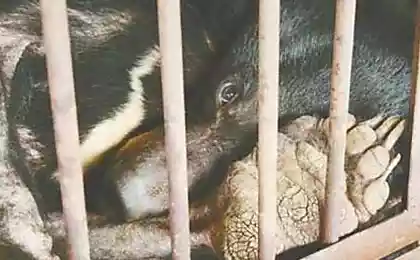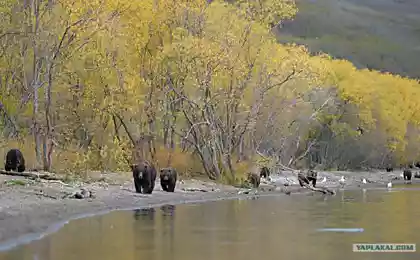775
Feast on bearish outside: Kamchatka fishermen
He writes naturalist and researcher Igor Shpilenok
A lovely July morning. I sit on the board rubber boats moored to a narrow sandy beach of North Bay. Layered fog creeps over the water from it appear and disappear the top of the volcano and the Wild Elias ridge. Along the shore sat hundreds of noisy gulls. The beach looked through three kilometers of four - to the mouth of the river Vychinkiya. The width of the beach up to eight meters on a wall of tall grass and trees. On this strip of sand I count sixteen sleeping bears, plus another five wandering along the water between the mouths of small rivers. How many of them in the alder-willow jungle, moving to the beach - no one knows. Next to me, literally ten feet, plump bright young bear standing in shallow estuary crowded sockeye river First North and lazily watching crawled through the sand roll back the red fish. Water boils and boils: the fish just do not fit into the mainstream of close and sometimes pushes each other on the beach. Externally, the salmon is easy to guess what the most difficult test they had to move: the body covered with old scars and fresh lacerations, many do not have fins, sockeye salmon are found even without eyes, but they tend to go to the river and get to the spawning grounds. Stop them only death.
16 ph + letter

Hundreds of dead fish have a pale color lie on the sand. The lake waves rocking thousands of all fish at the entrance to the river. Fish, of course, sees the bear, but she can not go into the river, it can not act against the powerful instinct of reproduction. The queue at the bear claws ... From time to time the bear experienced eye chooses sacrifice - it's always a gravid female. Fish have nowhere to flee from a bear - it is from all sides backed bodies of their neighbors - people in a queue on the escalator of the Moscow metro during rush hour. Dipper slowly comes one paw raised fish on his head, and the second claw feet, like a scalpel, carefully opens the belly without damaging the roe yastiks. Beast-only gourmet sucks eggs and calmly pushes moribund fish. Free immediately take the following sockeye. The procedure is repeated dozens of times to complete satiety Bears of caviar, then it goes to the beach, dig a circular hole, neatly stacked in her saggy stomach and forget the food coma for about three hours to four. Difficult thing - to digest a few kilograms of high-calorie caviar. Place-bear in the creek right there takes a fun and unruly bear teenage Pushkin's whiskers. For similarities to so I called him Pushkin. It is fed to satiety and just playing with the big fish: missing their tails and fins, throws up on themselves. He later gives way to a couple of other bear teens, but they play more than eating. With the abundance of local food gourmet bears show different inclinations, some bears eat only eggs, some only hryaschik sockeye salmon color, some like to suck the fish eyes. Bear Pig prefers to eat dead fish half-decayed, and she was gaining weight the fastest.
From July until the occurrence of the den in fish feast brown bears. The exceptional abundance of food here ensures the existence of the bear population with the highest density in the world. For one day, circling the lake on the boat, I was able to observe up to a hundred bears, and in the mouths of the tributaries of the lake as the river Hakytsyn Etamynk and sometimes you can see up to 15 bears at once. Experts believe that all lives in the reserve of at least 800 bears, but rather about a thousand individuals. Another feature of the local population - the large number of large animals - they are about five times more than in the adjacent hunting areas. In addition, there is a perfectly ordinary meeting bears with three or even four cubs - food lacks everything.
Bears waiting for the approach of the fish.
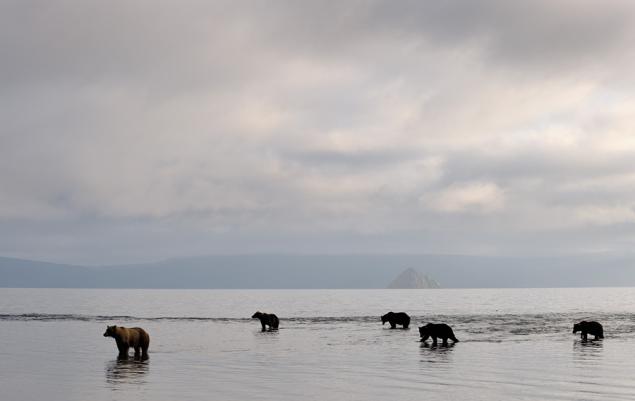
Kamchatka - the world's only a bear region, where there are three main types of fattening feed: berries, pine nuts, and a passing salmon, five species of which succeed each other on the spawning grounds from June until the beginning of February. Semidecomposed salmon lying on the bottom of reservoirs, are available for bears even in the spring, after leaving the den. For comparison - the bears are gaining the necessary Siberia for the winter fat, eating berries and pine nuts, the bears of Alaska - salmon and berries. Besides Kamchatka bears are important supplements to the main menu - Emissions sea (seaweed, dead fish, shellfish, birds, marine mammals, including the multi-ton dead whale carcasses). Cranks, that is not scored and is lying fat for the winter in a den bears are rare, as the coincidence of all three major crop failure forages unlikely. But even among the Kamchatka bears, the population that lives around the Kurile Lake, is in a privileged state, because nowhere is no longer so easy access to abundant and so much high-quality protein foods. (Add to this, and the fact that the animals here are protected by the Federal Reserve with the real inspector guard!) For equal time spent eating, say, fish and berries, the bear gets 10 times more calories from fish than from the berries! Because of this bears on the lake have more time to sleep and play - I could not be anywhere else to shoot as many bears playing like here. In addition, many bears are protected in the reserve, not afraid of people, so do not waste energy on avoiding human. But it is doubtful advantage, it can be fatal if the animal will go beyond the protected area or meet with a poacher in the reserve.
In the south of Kamchatka there is one big advantage for the bears - the conditions of occurrence of hibernation is also very favorable: steep slopes, impassable for people cedar and alder elfin and very deep snow - here he reaches three meters. Kuril Lake has unique conditions for dens - frozen cave on the island lavas Samang, a favorite place for wintering bears with cubs. Bears - excellent swimmers, they can spend hours in the icy water and easily cross the lake in either direction, constantly surveying the island. For example, on a rocky island Alaid Heart, located 4 kilometers from the nearest land, bears collect the eggs and chicks of Pacific gulls. I have often seen bears in middle of the lake, and they swim a lot faster than I rowed in a rubber boat.
Sockeye salmon and the bear.

04
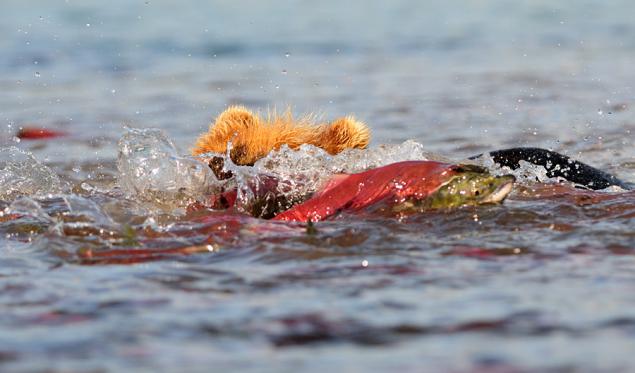
05
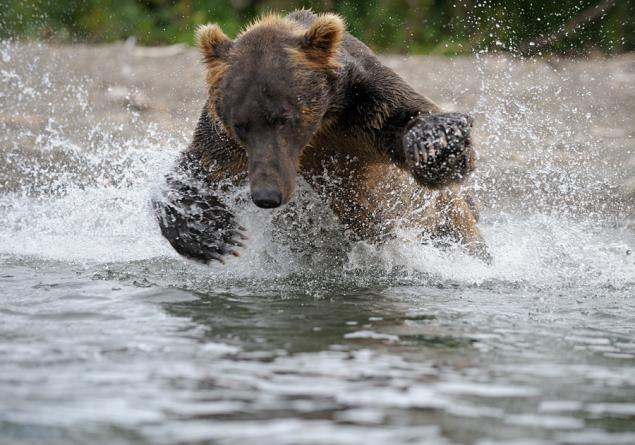
06

Bear watching fish.

Young angler.

Matuh not feed their children fish. Teddy bear eats the remains of a meal or just a parent pull the prey from the claws of the parent.

10

11

A rare case of two-bear catching fish.
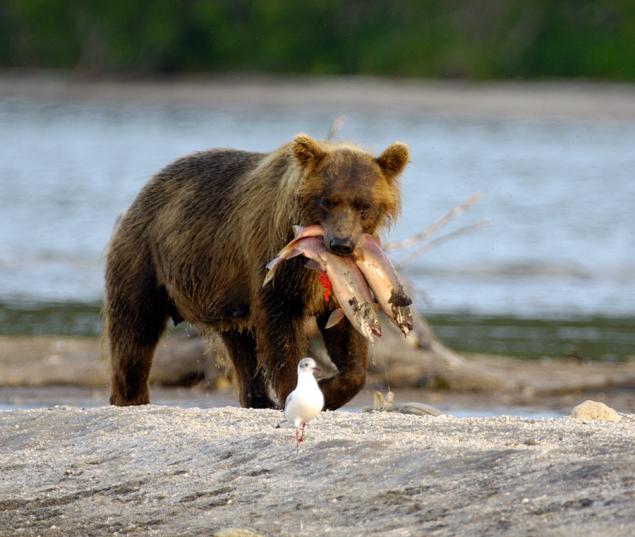
Bear triple. Two bear teenager trying to take away the prey of his mother, but she runs away.

Psychological match.

The best place for fishing is the strong.

Beach Kurile Lake - Bear paradise.
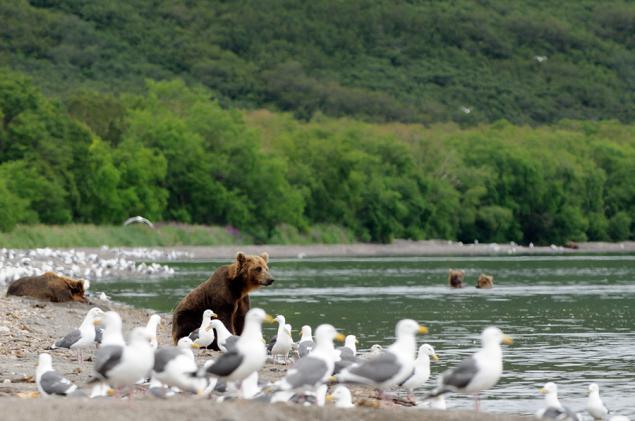
Source:
A lovely July morning. I sit on the board rubber boats moored to a narrow sandy beach of North Bay. Layered fog creeps over the water from it appear and disappear the top of the volcano and the Wild Elias ridge. Along the shore sat hundreds of noisy gulls. The beach looked through three kilometers of four - to the mouth of the river Vychinkiya. The width of the beach up to eight meters on a wall of tall grass and trees. On this strip of sand I count sixteen sleeping bears, plus another five wandering along the water between the mouths of small rivers. How many of them in the alder-willow jungle, moving to the beach - no one knows. Next to me, literally ten feet, plump bright young bear standing in shallow estuary crowded sockeye river First North and lazily watching crawled through the sand roll back the red fish. Water boils and boils: the fish just do not fit into the mainstream of close and sometimes pushes each other on the beach. Externally, the salmon is easy to guess what the most difficult test they had to move: the body covered with old scars and fresh lacerations, many do not have fins, sockeye salmon are found even without eyes, but they tend to go to the river and get to the spawning grounds. Stop them only death.
16 ph + letter

Hundreds of dead fish have a pale color lie on the sand. The lake waves rocking thousands of all fish at the entrance to the river. Fish, of course, sees the bear, but she can not go into the river, it can not act against the powerful instinct of reproduction. The queue at the bear claws ... From time to time the bear experienced eye chooses sacrifice - it's always a gravid female. Fish have nowhere to flee from a bear - it is from all sides backed bodies of their neighbors - people in a queue on the escalator of the Moscow metro during rush hour. Dipper slowly comes one paw raised fish on his head, and the second claw feet, like a scalpel, carefully opens the belly without damaging the roe yastiks. Beast-only gourmet sucks eggs and calmly pushes moribund fish. Free immediately take the following sockeye. The procedure is repeated dozens of times to complete satiety Bears of caviar, then it goes to the beach, dig a circular hole, neatly stacked in her saggy stomach and forget the food coma for about three hours to four. Difficult thing - to digest a few kilograms of high-calorie caviar. Place-bear in the creek right there takes a fun and unruly bear teenage Pushkin's whiskers. For similarities to so I called him Pushkin. It is fed to satiety and just playing with the big fish: missing their tails and fins, throws up on themselves. He later gives way to a couple of other bear teens, but they play more than eating. With the abundance of local food gourmet bears show different inclinations, some bears eat only eggs, some only hryaschik sockeye salmon color, some like to suck the fish eyes. Bear Pig prefers to eat dead fish half-decayed, and she was gaining weight the fastest.
From July until the occurrence of the den in fish feast brown bears. The exceptional abundance of food here ensures the existence of the bear population with the highest density in the world. For one day, circling the lake on the boat, I was able to observe up to a hundred bears, and in the mouths of the tributaries of the lake as the river Hakytsyn Etamynk and sometimes you can see up to 15 bears at once. Experts believe that all lives in the reserve of at least 800 bears, but rather about a thousand individuals. Another feature of the local population - the large number of large animals - they are about five times more than in the adjacent hunting areas. In addition, there is a perfectly ordinary meeting bears with three or even four cubs - food lacks everything.
Bears waiting for the approach of the fish.

Kamchatka - the world's only a bear region, where there are three main types of fattening feed: berries, pine nuts, and a passing salmon, five species of which succeed each other on the spawning grounds from June until the beginning of February. Semidecomposed salmon lying on the bottom of reservoirs, are available for bears even in the spring, after leaving the den. For comparison - the bears are gaining the necessary Siberia for the winter fat, eating berries and pine nuts, the bears of Alaska - salmon and berries. Besides Kamchatka bears are important supplements to the main menu - Emissions sea (seaweed, dead fish, shellfish, birds, marine mammals, including the multi-ton dead whale carcasses). Cranks, that is not scored and is lying fat for the winter in a den bears are rare, as the coincidence of all three major crop failure forages unlikely. But even among the Kamchatka bears, the population that lives around the Kurile Lake, is in a privileged state, because nowhere is no longer so easy access to abundant and so much high-quality protein foods. (Add to this, and the fact that the animals here are protected by the Federal Reserve with the real inspector guard!) For equal time spent eating, say, fish and berries, the bear gets 10 times more calories from fish than from the berries! Because of this bears on the lake have more time to sleep and play - I could not be anywhere else to shoot as many bears playing like here. In addition, many bears are protected in the reserve, not afraid of people, so do not waste energy on avoiding human. But it is doubtful advantage, it can be fatal if the animal will go beyond the protected area or meet with a poacher in the reserve.
In the south of Kamchatka there is one big advantage for the bears - the conditions of occurrence of hibernation is also very favorable: steep slopes, impassable for people cedar and alder elfin and very deep snow - here he reaches three meters. Kuril Lake has unique conditions for dens - frozen cave on the island lavas Samang, a favorite place for wintering bears with cubs. Bears - excellent swimmers, they can spend hours in the icy water and easily cross the lake in either direction, constantly surveying the island. For example, on a rocky island Alaid Heart, located 4 kilometers from the nearest land, bears collect the eggs and chicks of Pacific gulls. I have often seen bears in middle of the lake, and they swim a lot faster than I rowed in a rubber boat.
Sockeye salmon and the bear.

04

05

06

Bear watching fish.

Young angler.

Matuh not feed their children fish. Teddy bear eats the remains of a meal or just a parent pull the prey from the claws of the parent.

10

11

A rare case of two-bear catching fish.

Bear triple. Two bear teenager trying to take away the prey of his mother, but she runs away.

Psychological match.

The best place for fishing is the strong.

Beach Kurile Lake - Bear paradise.

Source:
